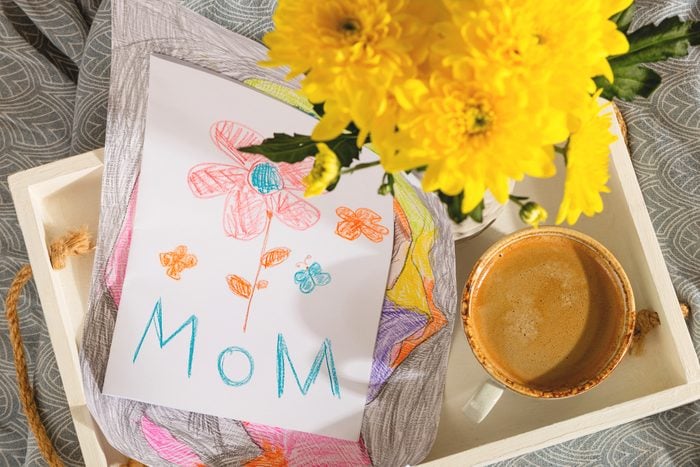When Is Mother’s Day, and Why Do We Celebrate It?
Updated: Apr. 16, 2024

Don't forget to call your mom! But first you'll need to know: When is Mother's Day?
You have a lot going on, so we’ll forgive you for asking, “When is Mother’s Day?” once or twice this month. (Oh, fine, it might’ve been three times, but you have a lot going on.) Don’t panic—it hasn’t happened yet! The holiday is in May, so you still have time to figure out the best Mother’s Day ideas for spoiling and celebrating the mothers in your life.
And yes, it’s important to do so. You don’t remember it, but your birthday (or adoption day) was a big event for two people: you and the person you made a new mother in that instant. Ever since that fateful day, she’s gone on to play a lot of roles in your life. Mothers guide, teach, nurture, love, discipline, snuggle, feed, laugh and so much more. This year, honor her with Mother’s Day gifts she’s guaranteed to love, including a printable Mother’s Day card you can personalize just for her.
We’re answering your most pressing questions about the holiday here, including “When is Mother’s Day this year?” and “What Mother’s Day history do I need to know to impress my mom and earn favorite-child status?” Keep reading for the answers to those questions and the story behind this treasured day.
Get Reader’s Digest’s Read Up newsletter for more holiday tips, fun facts, humor, cleaning, travel and tech all week long.
When is Mother’s Day 2024?
This year, Mother’s Day is on Sunday, May 12, 2024. That should give you plenty of time to come up with a celebration that’ll wow her. Or, you know, create a playlist of mom songs to bring on the waterworks.
Unlike holidays with a set date, Mother’s Day has more to do with a specific day of the week than a specific date. It falls on the second Sunday in May each year. Not that good with mental calendar math? We’ve calculated the dates for the next five Mother’s Days for you:
- Sunday, May 11, 2025
- Sunday, May 10, 2026
- Sunday, May 9, 2027
- Sunday, May 14, 2028
- Sunday, May 13, 2029
What is the history of Mother’s Day?

Even though mothers have existed since the beginning of humanity, celebrating Mother’s Day as a formal holiday is a fairly recent invention. It begins, like so many mom stories, with a powerful bond between a mother and daughter.
Ann Reeves Jarvis, known as Mother Jarvis, was a mother and Sunday-school teacher in rural West Virginia—until the Civil War broke out in 1861. She then became an activist for human rights and mothers, no matter which side of the blue-gray divide they were on. To begin, she organized “mothers’ day work clubs.” These clubs taught mothers basic health, hygiene and child-rearing skills to fight the unsanitary living conditions that caused so much death and disease in young children. She went on to organize “women’s brigades” to help wounded soldiers and a Mothers’ Friendship Day to improve relations between former Union and Confederate families. After all, if anyone can calm down a heated argument, it’s a mother.
Mother Jarvis’s daughter, Anna M. Jarvis, was her devoted disciple and served beside her mother. As Mother Jarvis’s health declined, Anna became her caretaker, devoting years to her beloved mom. On May 8, 1905, Mother Jarvis died of heart complications.
Anna, by then a young mother herself, was devastated by the loss. In 1906, she invited friends and family to a special church service to honor her mother on the one-year anniversary of her death. She handed out carnations, Mother Jarvis’s favorite flower, to all the mothers in attendance. (The origin of Mother’s Day flowers, perhaps?) It was such a moving tribute that Anna and her loved ones decided to keep the tradition going each May. They broadened the celebration to include mothers in general.
Anna went on a campaign to spread her favorite holiday, writing letters, petitioning politicians and talking about her mother to anyone who would listen. In 1915, her efforts paid off. President Woodrow Wilson declared Mother’s Day an annual national observance in the United States, to be held on the second Sunday of May.
Why is it called Mother’s Day?

More perplexing than the question “When is Mother’s Day?” is the question of why the holiday’s name is singular, not plural—Mother’s Day, not Mothers’ Day. Anna Jarvis was adamant that it be dedicated to just one mother. Its purpose, she said, is “to honor the best mother who ever lived: yours.”
Some great ways to honor your mom on Mother’s Day:
- Create a photo album of mother-child moments and decorate it with mother-daughter quotes, mother-son quotes, tender words and inside jokes.
- Make her a special Mother’s Day brunch. Pancakes and mimosas, anyone?
- Send her a lovely bouquet of flowers that show just how much you care. Websites offering online flower-delivery services have gorgeous options!
When is Mother’s Day celebrated in other countries?

More than 50 countries around the world celebrate Mother’s Day. Many of these celebrations share the same date as the U.S. holiday, including those in Australia, Brazil, Belgium, Czech Republic, Denmark, Fiji, Netherlands, New Zealand, Taiwan and Venezuela. These countries share similar traditions of honoring mothers with store-bought and DIY gifts, flowers and food. There are also countries that do things a little differently.
Egypt
Many Middle Eastern countries, including Egypt, Iran, Iraq and Bahrain, celebrate Mother’s Day on March 21, the spring equinox. Egyptians started the holiday to honor Isis, the goddess seen as the ideal of motherhood. Today, Egyptian children write their moms thank-you notes and do all the household chores that day.
Hungary
Mother’s Day in Hungary is celebrated on the first Sunday of May. Young children make handmade cards and crafts to give to their mothers. Lilacs are the official flower of Mother’s Day in Hungary, and many bouquets are handed out.
Ireland
The Irish celebrate Mother’s Day on the fourth Sunday during Lent. They start the holiday by attending a special church service dedicated to Mary, the mother of Jesus. Afterward, children present their mothers with hand-picked bouquets and small gifts.
Israel
Israeli Mother’s Day is celebrated on Shvat 30, a Sabbath day that falls between Jan. 30 and March 1, depending on the Jewish calendar. In the 1990s, the government changed the holiday from Mother’s Day to Family Day to acknowledge the changing roles and structures of modern families.
Russia
Mother’s Day in Russia is celebrated in the fall, on the last Sunday in November. But this holiday is comparatively small, and Russian mothers are more formally celebrated on International Women’s Day, on March 8. Children are expected to give their mother flowers but also honor and congratulate all maternal figures in their lives, including grandmothers, mothers-in-law and aunts.
Fun facts about moms and Mother’s Day

You can break out the mom jokes and Mother’s Day poems during Mother’s Day brunch, but if you really want to impress Mom with your ability to collect random bits of trivia, share these Mother’s Day facts:
- More phone calls are made on Mother’s Day than any other day of the year, causing phone usage to go up by as much as 37%.
- Following its founder’s lead, carnations remain the official flower of Mother’s Day in the United States.
- One-quarter of all flower and plant purchases made for a holiday happen around Mother’s Day.
- Mother’s Day is the busiest day of the year for restaurants in America, with brunch being the most popular meal.
- Anna Jarvis tried to stop Mother’s Day just five years after getting it officially recognized. She said it had become too commercialized and hated it until she died in 1948.
- Cards are the most popular “gift” given on Mother’s Day, with more than 120 million sent each year. But your mom may just want the gift of time spent with her kids. So take her to lunch, plan a family outing or simply curl up on the couch and watch one of these mom movies.
Now we hope you can confidently answer the question “When is Mother’s Day?” and proceed to spoil the wonderful moms in your life accordingly.
Why trust us
At Reader’s Digest, we’re committed to producing high-quality content by writers with expertise and experience in their field in consultation with relevant, qualified experts. We rely on reputable primary sources, including government and professional organizations and academic institutions as well as our writers’ personal experience where appropriate. We verify all facts and data, back them with credible sourcing, and revisit them over time to ensure they remain accurate and up to date. Read more about our team, our contributors and our editorial policies.
Sources:
- Farmer’s Almanac: “Have a Happy Mother’s Day 2024: Facts, Folklore, Recipes, and Ideas”
- Discovering Ireland: “Mother’s Day in Ireland”
- Israel21c: “The story of how Israel’s Mother’s Day became Family Day”
- ProFlowers: “Mother’s Day Flower Statistics”
- FSR Magazine: “Dollar Days”



